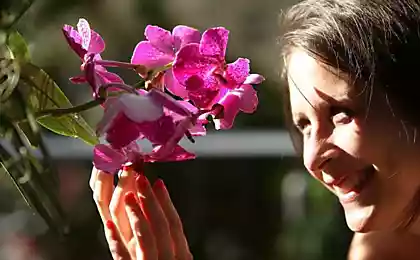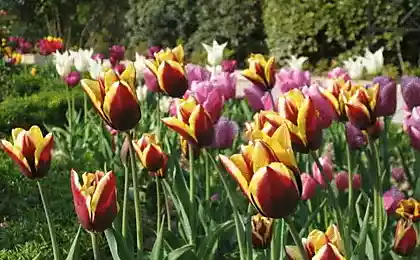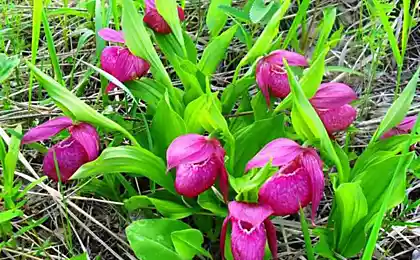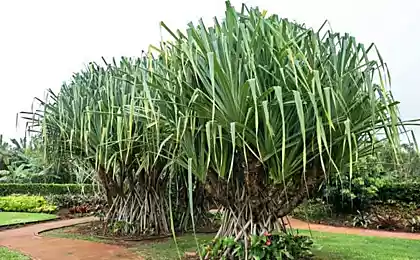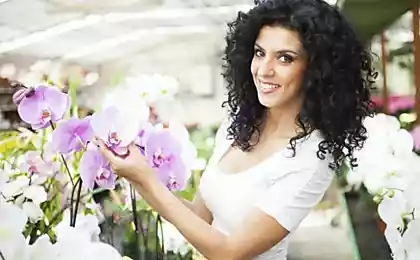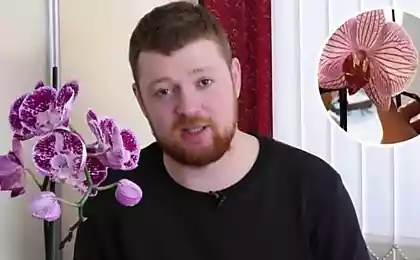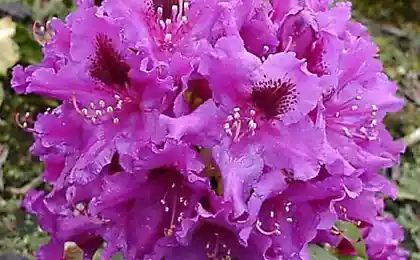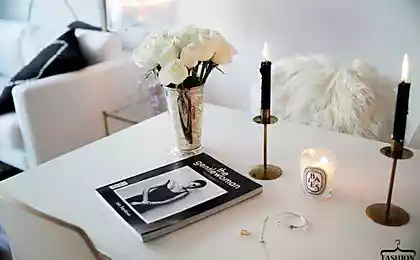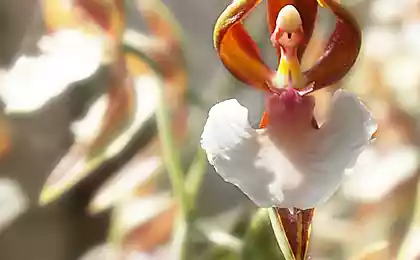582
Why not bloom orchids — practical advice gardeners
Phalaenopsis and Dendrobium traditionally are the most blooming orchids, but sometimes flowering may not occur. This problem occurs most novice gardeners.
Many are asking,"why does not bloom, the Orchid, and what to do to make it bloom?" Let's consider the main reasons for the lack of flowering of this beautiful plant.

This can occur due to poor lighting could not have been observed in the dormant period of the plant, or its overfed fertilizer with nitrogen. If it is determined that the plant is overfed, in this case it is necessary to wait only when the nitrogen is recycled, and at this time to make phosphorus. The air in the room must be well hydrated and illuminated, and the drafts generally unacceptable for orchids.
Orchids are light-loving plants.If there is lack in sunlight, the flowering of this plant, you can not wait, as it will thrive only one green. The Cymbidium Orchid grows only in bright light, and in their familiar environment it generally grows under direct sunlight. Under indoor cultivation of this variety, the lack of light is the cause is not the onset of flowering. But the dark green foliage on a plant is built up very well in these conditions.
Another reason for which Orchid does not bloom, is excess moisture, especially when you start to be laid and formed buds of future flowers. If the Orchid be watered abundantly, the plant you will notice the dried buds or dry, undiscovered stalks. Almost all types of orchids-epiphytes begin their flowering after completion of growth. But until that time, the plant must be heavily watered.
During flowering orchids need a lot of moisture.
A rest period occurs in this plant after flowering and in winter, when lighting is poor and the low temperature of the air in the room. In those days, watering should be reduced. To form new flower stalks on the orchids, most of them need rest. The plant goes into a relaxed state when ripen all new bulbs, that is all that appears, the sprouts become as tall as the old one.
During this period, orchids need a room a little colder, and the soil somewhat drier. In winter the Orchid is better placed this time in a less heated room, and in summer it is better to make the plant on the air – a balcony or a garden. There are orchids that require a temperature drop at night.
Fertilize during the rest period, the plant is not required.
After the about two months, this period will end and the plant will have new stems. How to make blossom Every Orchid grower is a pleasure to watch the blossoming Orchid.
If it is bought already with full-blown flowers, it is logical to expect it to blossom in the future. But, sometimes this does not happen, which confused the owner of the plant.
So how do you get an Orchid to bloom again?
And to solve this problem, actually, is quite simple, at some point they need to create for plants are the conditions close to natural. If the Orchid does not bloom long, so you need to make certain changes in care.
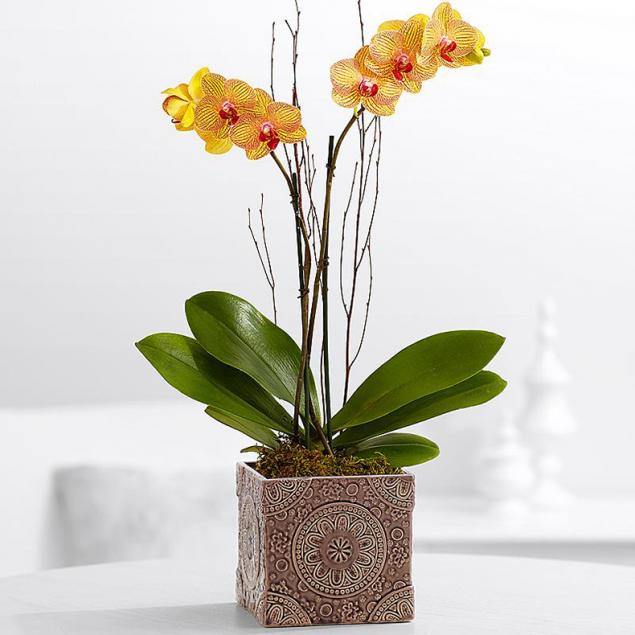
So that Orchid began to produce gorgeous flowers, she needs to create stressful conditions, such as a sharp jump in temperature from cold to warmer. You can plant at night to put in a room with a temperature of 18 °C, and in the morning move it to a warmer room.
Flowering orchids can cause abrupt cessation of irrigation, it can act on many species of orchids. If irrigation is to continue in the same way, the plant will go instead of flowering into a new growing season. The natural habitat of epiphytic orchids are tropical, where there's a time when rainfall is either too much, or not at all.
In the dry season the orchids get enough water for life, but for the growth of foliage this little number. In dry period, orchids are forced to go into a dormant stage, but this process is gradual, only when fully completed vegetation. Watering restrictions for orchids can last one or several months.
Flower shops offer for sale Cumbria (Oncidium, Milton and their hybrids) this epiphytic orchids, requiring reduction of irrigation in the development of the palpal bulb. Less moisture is required of them when they had almost grown, and then orchids will surely bloom. Only have to water a little sooner than the end of the growing season.
For each type of orchids need to know their terms when they want to reduce the glaze. Some orchids respond to the termination of the supply of moisture very rapidly, they can even slow down its growth to the development of the peduncle.
There are types of orchids that needs to reduce watering when the bulb will grow by a third from their usual size. But that Orchid bloomed, her Bulba needs to grow a normal size, characteristic of this type. If the plant is weakened and small bulbs, flowering may not occur.
But, if the plant is Mature, has a large biomass and is in adverse conditions, even small bulbs can bloom. There are orchids, which are in the same place, growing all the time and they develop bulbs, but flowering occurs spontaneously after a long break. Moreover, the conditions of detention of the flower does not change.
This is due to the partial dying off of the roots. If the Orchid is growing in a pot, the roots live only two to three years. The root system becomes smaller and the plant starts to get less moisture, which gives impetus to the development of buds and stems. And flowering shoots can be of different ages throughout the year.
Hybrids such as Phalaenopsis, flowering begins in spring and again in autumn. If the lighting is good, the hybrid Vanda also will behave. If grower a vacation in July, it is quite possible he knocked a normal irrigation mode hybrid orchids. And this affects the development of the peduncle in August. If the Orchid Vanda to grow in a bright South window, with sharp changes in air temperature and with a temporary reduction of irrigation that this hybrid will bloom in the spring, if it was in good condition.

Most hybrids bloom Pafiopedilyumy, when they reduce watering, even without changing the temperature of the contents. Their flowering occurs from the topmost buds of the plant. Even while on the North window, to the experienced grower, this species can bloom. But still, any Orchid you need to change the temperature in certain periods, to better formed stems.
The incorrect action in relation to the care of orchids is excess moisture. It promotes early vegetation buds, the plant is in growth, thereby blocking the laying of the stalks (especially when apical flowering orchids). With abundant watering the buds and flower stalks in its infancy, which is located on the old bollbach, wither. If the natural habitats of orchids are mountainous terrain, with the constantly humid climate, they bloom almost non-existent or it is not long lasting and the plant is constantly in the growing season.
For example, this Orchid is Miltoniopsis. The natural conditions in which this plant lives, suggest year-round presence of precipitation of 30 mm to 600 mm. If there is less precipitation, flowering begins after the maturation of new shoots continues throughout the year. She was Orchid, consuming the moisture contained in fog and dew.
If a lot of precipitation, blooming Orchid is very bad and once a year, lasting from 1 to 3 months. For novice gardeners, the Phalaenopsis Orchid is the best option, as this kind of blossom long enough and the plant is more adapted to home growing.
Do I need to crop withered Orchid? Well, Orchid and faded.... Many novice growers wonder "whether or not to circumcise stems orchids Il still leave?"
Here you can safely say that the rush to cut off the flower stalk after flowering is not necessary, because it is ready for further treatments. It is cut only when completely dry. If the Orchid blooms on a single shoot a second time (like Phalaenopsis), then it should not be completely removed after each bloom. It formed new flower buds.
If the grower does not like the look of the faded plants, you can remove the stem by cutting it above the third Bud from the bottom. From the top of the kidneys need to leave 0.5 cm. in about four, five months perhaps the emergence of new flower arrows on the old stems. This branching depends on the conditions of detention of a flower.
If the old arrow will wither and dry out, then the new one will be appear a little longer. When drying, the stem must be cut off at the alive green of the hands and a cut to disinfect activated carbon, crushed to a powder. You can paint over the cut with iodine, brilliant green or sprinkle with cinnamon.
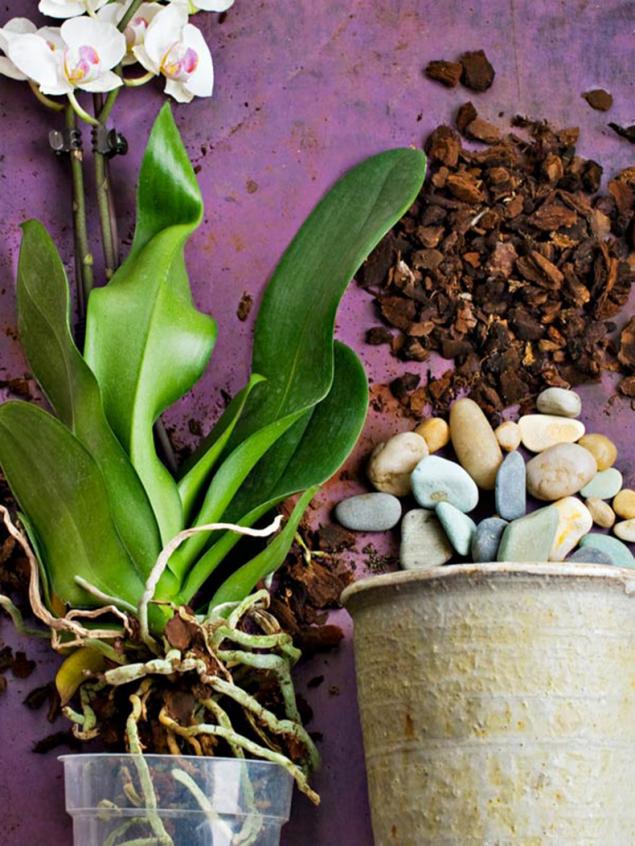
After flowering it is possible to replace the soil and the removal of dead roots. And it is not necessary to postpone these procedures in the spring. Most orchids fading enter a dormant stage and begin to increase its green weight. With the appearance in the home of a new flower, you need to wait until he adapts to the new place. To do this, cropped very short peduncle and plant a few months gaining strength for the next flowering. published
P. S. And remember, only by changing their consumption — together we change the world! ©
Join us in Facebook , Vkontakte, Odnoklassniki
Source: www.sadproekt.ru/pochemu-ne-cvetet-orhideya
Many are asking,"why does not bloom, the Orchid, and what to do to make it bloom?" Let's consider the main reasons for the lack of flowering of this beautiful plant.

This can occur due to poor lighting could not have been observed in the dormant period of the plant, or its overfed fertilizer with nitrogen. If it is determined that the plant is overfed, in this case it is necessary to wait only when the nitrogen is recycled, and at this time to make phosphorus. The air in the room must be well hydrated and illuminated, and the drafts generally unacceptable for orchids.
Orchids are light-loving plants.If there is lack in sunlight, the flowering of this plant, you can not wait, as it will thrive only one green. The Cymbidium Orchid grows only in bright light, and in their familiar environment it generally grows under direct sunlight. Under indoor cultivation of this variety, the lack of light is the cause is not the onset of flowering. But the dark green foliage on a plant is built up very well in these conditions.
Another reason for which Orchid does not bloom, is excess moisture, especially when you start to be laid and formed buds of future flowers. If the Orchid be watered abundantly, the plant you will notice the dried buds or dry, undiscovered stalks. Almost all types of orchids-epiphytes begin their flowering after completion of growth. But until that time, the plant must be heavily watered.
During flowering orchids need a lot of moisture.
A rest period occurs in this plant after flowering and in winter, when lighting is poor and the low temperature of the air in the room. In those days, watering should be reduced. To form new flower stalks on the orchids, most of them need rest. The plant goes into a relaxed state when ripen all new bulbs, that is all that appears, the sprouts become as tall as the old one.
During this period, orchids need a room a little colder, and the soil somewhat drier. In winter the Orchid is better placed this time in a less heated room, and in summer it is better to make the plant on the air – a balcony or a garden. There are orchids that require a temperature drop at night.
Fertilize during the rest period, the plant is not required.
After the about two months, this period will end and the plant will have new stems. How to make blossom Every Orchid grower is a pleasure to watch the blossoming Orchid.
If it is bought already with full-blown flowers, it is logical to expect it to blossom in the future. But, sometimes this does not happen, which confused the owner of the plant.
So how do you get an Orchid to bloom again?
And to solve this problem, actually, is quite simple, at some point they need to create for plants are the conditions close to natural. If the Orchid does not bloom long, so you need to make certain changes in care.

So that Orchid began to produce gorgeous flowers, she needs to create stressful conditions, such as a sharp jump in temperature from cold to warmer. You can plant at night to put in a room with a temperature of 18 °C, and in the morning move it to a warmer room.
Flowering orchids can cause abrupt cessation of irrigation, it can act on many species of orchids. If irrigation is to continue in the same way, the plant will go instead of flowering into a new growing season. The natural habitat of epiphytic orchids are tropical, where there's a time when rainfall is either too much, or not at all.
In the dry season the orchids get enough water for life, but for the growth of foliage this little number. In dry period, orchids are forced to go into a dormant stage, but this process is gradual, only when fully completed vegetation. Watering restrictions for orchids can last one or several months.
Flower shops offer for sale Cumbria (Oncidium, Milton and their hybrids) this epiphytic orchids, requiring reduction of irrigation in the development of the palpal bulb. Less moisture is required of them when they had almost grown, and then orchids will surely bloom. Only have to water a little sooner than the end of the growing season.
For each type of orchids need to know their terms when they want to reduce the glaze. Some orchids respond to the termination of the supply of moisture very rapidly, they can even slow down its growth to the development of the peduncle.
There are types of orchids that needs to reduce watering when the bulb will grow by a third from their usual size. But that Orchid bloomed, her Bulba needs to grow a normal size, characteristic of this type. If the plant is weakened and small bulbs, flowering may not occur.
But, if the plant is Mature, has a large biomass and is in adverse conditions, even small bulbs can bloom. There are orchids, which are in the same place, growing all the time and they develop bulbs, but flowering occurs spontaneously after a long break. Moreover, the conditions of detention of the flower does not change.
This is due to the partial dying off of the roots. If the Orchid is growing in a pot, the roots live only two to three years. The root system becomes smaller and the plant starts to get less moisture, which gives impetus to the development of buds and stems. And flowering shoots can be of different ages throughout the year.
Hybrids such as Phalaenopsis, flowering begins in spring and again in autumn. If the lighting is good, the hybrid Vanda also will behave. If grower a vacation in July, it is quite possible he knocked a normal irrigation mode hybrid orchids. And this affects the development of the peduncle in August. If the Orchid Vanda to grow in a bright South window, with sharp changes in air temperature and with a temporary reduction of irrigation that this hybrid will bloom in the spring, if it was in good condition.

Most hybrids bloom Pafiopedilyumy, when they reduce watering, even without changing the temperature of the contents. Their flowering occurs from the topmost buds of the plant. Even while on the North window, to the experienced grower, this species can bloom. But still, any Orchid you need to change the temperature in certain periods, to better formed stems.
The incorrect action in relation to the care of orchids is excess moisture. It promotes early vegetation buds, the plant is in growth, thereby blocking the laying of the stalks (especially when apical flowering orchids). With abundant watering the buds and flower stalks in its infancy, which is located on the old bollbach, wither. If the natural habitats of orchids are mountainous terrain, with the constantly humid climate, they bloom almost non-existent or it is not long lasting and the plant is constantly in the growing season.
For example, this Orchid is Miltoniopsis. The natural conditions in which this plant lives, suggest year-round presence of precipitation of 30 mm to 600 mm. If there is less precipitation, flowering begins after the maturation of new shoots continues throughout the year. She was Orchid, consuming the moisture contained in fog and dew.
If a lot of precipitation, blooming Orchid is very bad and once a year, lasting from 1 to 3 months. For novice gardeners, the Phalaenopsis Orchid is the best option, as this kind of blossom long enough and the plant is more adapted to home growing.
Do I need to crop withered Orchid? Well, Orchid and faded.... Many novice growers wonder "whether or not to circumcise stems orchids Il still leave?"
Here you can safely say that the rush to cut off the flower stalk after flowering is not necessary, because it is ready for further treatments. It is cut only when completely dry. If the Orchid blooms on a single shoot a second time (like Phalaenopsis), then it should not be completely removed after each bloom. It formed new flower buds.
If the grower does not like the look of the faded plants, you can remove the stem by cutting it above the third Bud from the bottom. From the top of the kidneys need to leave 0.5 cm. in about four, five months perhaps the emergence of new flower arrows on the old stems. This branching depends on the conditions of detention of a flower.
If the old arrow will wither and dry out, then the new one will be appear a little longer. When drying, the stem must be cut off at the alive green of the hands and a cut to disinfect activated carbon, crushed to a powder. You can paint over the cut with iodine, brilliant green or sprinkle with cinnamon.

After flowering it is possible to replace the soil and the removal of dead roots. And it is not necessary to postpone these procedures in the spring. Most orchids fading enter a dormant stage and begin to increase its green weight. With the appearance in the home of a new flower, you need to wait until he adapts to the new place. To do this, cropped very short peduncle and plant a few months gaining strength for the next flowering. published
P. S. And remember, only by changing their consumption — together we change the world! ©
Join us in Facebook , Vkontakte, Odnoklassniki
Source: www.sadproekt.ru/pochemu-ne-cvetet-orhideya
